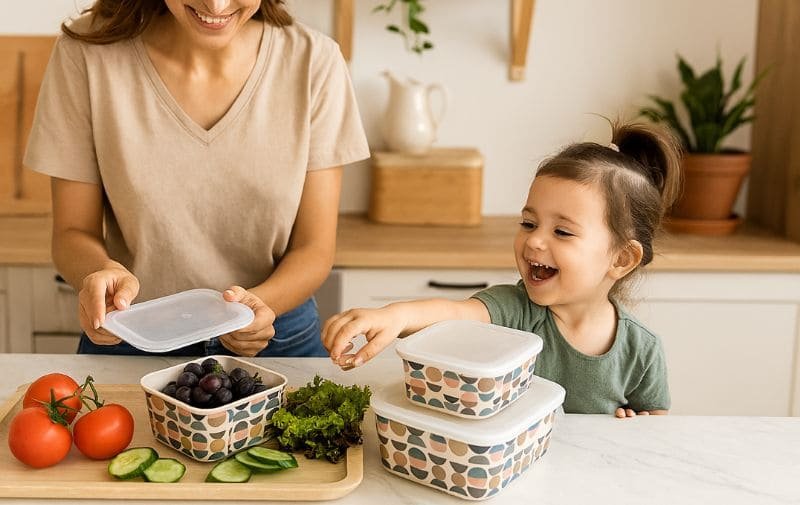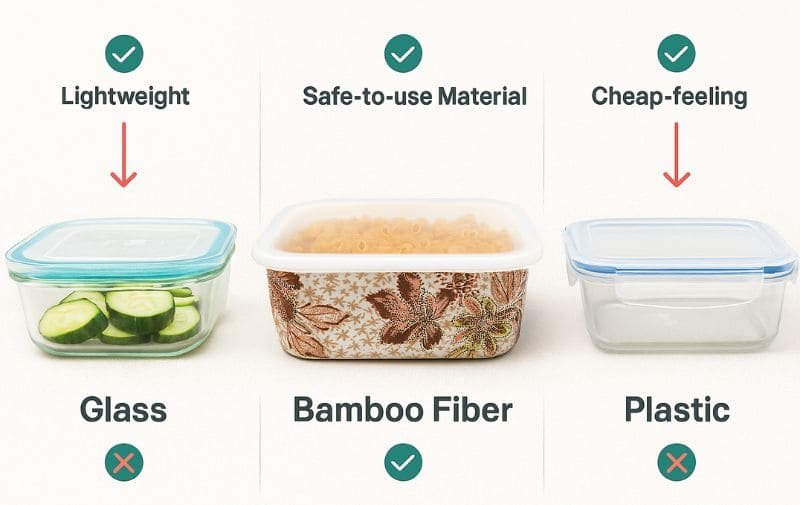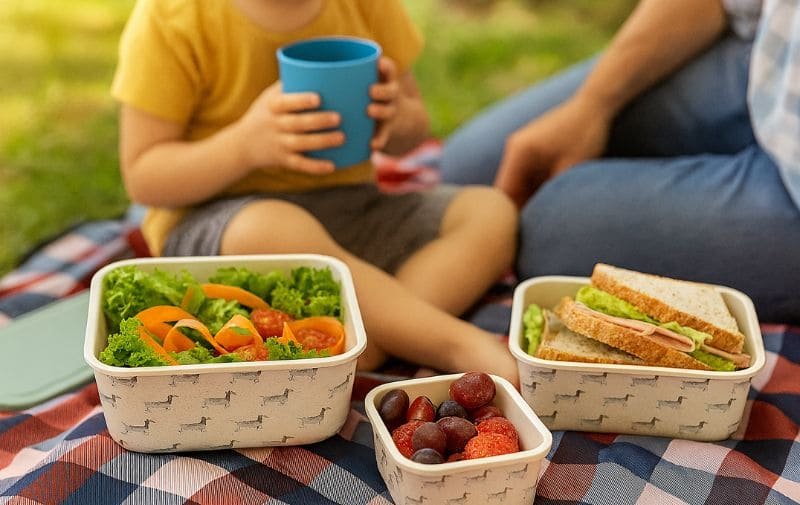Tired of that chaotic cabinet of mismatched plastic lids and heavy glass containers? You see those stylish, eco-friendly bamboo sets everywhere, but a little voice asks, “Are they actually safe for my food?”
Yes, high-quality bamboo fiber food containers are safe for storing most foods. Their safety comes from the food-grade A5 melamine resin used as a binder. They are perfect for cold storage, but the base should never be microwaved.
This guide we’ll break down their true composition, outline the non-negotiable safety rules, compare them to glass and steel, and reveal why their smart design is a favorite for both home users and professional buyers.
Last Updated: June 30th. 2025 | Estimated Reading Time: 9 Minutes
What Is a “Bamboo Fiber” Food Container Really Made Of?
You see “bamboo” in the name and picture a solid piece of wood, but the lightweight, rigid feel tells a different story. What’s the secret?
It’s a composite material, not pure bamboo. It’s made of fine bamboo powder bound together by food-grade A5 melamine resin. This creates a product that is about 40-45% bamboo fiber and 40-50% resin, giving it strength and a unique look.

This is the most important fact to understand. These containers are not carved from stalks of bamboo. Instead, they are the product of a smart manufacturing process that combines natural materials with a strong polymer.
Unpacking the Composite: Bamboo + Resin
Here’s how it works:
- Bamboo Powder: Mature bamboo stalks are harvested, dried, and ground into a very fine, flour-like powder. This is the organic “filler” that gives the container its eco-friendly credentials and unique texture.
- The Binder: This bamboo powder is then mixed with a resin binder to hold it all together. For a safe, high-quality container, this binder must be 100% A5 food-grade melamine resin.
- Molding: The mixture is placed in a mold and subjected to intense heat and pressure. This cures the thermoset resin, permanently binding the bamboo fibers into a solid, rigid, and durable shape. The final product is a lightweight yet strong material that feels more substantial than plastic but is less fragile than ceramic.
The Lid: A Different Material for a Reason
You’ll notice the lid is almost always a different material—a softer, more flexible plastic. This is a deliberate and crucial design choice. The lid is typically made from Polypropylene (PP, #5 plastic). While the bamboo-melamine base is completely rigid, PP is slightly flexible.
This flexibility is what allows the lid to snap on securely and create the airtight seal needed to keep your food fresh. It’s a hybrid design that gives you the best of both worlds: a stylish, rigid base and a functional, sealing lid.
Insider Tip: This hybrid design has a hidden benefit. While the bamboo base is NEVER microwave-safe, the PP plastic lid often is (check for the symbol). You can pop the lid onto a microwave-safe bowl to prevent splatters when reheating food.
The Ultimate Safety Checklist: Are They Safe for Your Family’s Food?
Okay, it’s a composite. But does that make it safe for storing my lunch or my kids’ snacks?
Yes, when made with certified A5 melamine resin, they are safe for most food storage. They are certified BPA-Free and pass FDA and LFGB tests. The golden rule is they are for storage, not for cooking—they are dishwasher and freezer safe, but not microwave safe.
The safety of a bamboo fiber container hinges entirely on the quality of the resin binder and how you use it. Let’s create a simple checklist.

Can you safely store hot, acidic, or oily foods in them?
For the most part, yes. These containers are perfect for storing cooled leftovers, salads (even with dressing), sandwiches, pasta, cut fruit, and other typical meal-prep items. The A5 resin is stable and won’t react with these foods. However, there are limits. They are designed for storage, not for long-term preservation of extremes. It’s best to avoid pouring piping hot soup directly from the stove into the container or storing highly acidic liquids (like a pure vinegar pickle brine) for many weeks.
Let hot foods cool for a few minutes before storing them to ensure the longest life for your container.
What certifications should you look for?
A reputable product’s safety is verified by independent testing. Look for these certifications:
- FDA (U.S. Food and Drug Administration): This ensures the product is safe for food contact under U.S. regulations.
- LFGB (Lebensmittel-, Bedarfsgegenstände- und Futtermittelgesetzbuch): This is the German food safety standard, which is often considered even stricter than the FDA’s. An LFGB certification is a very strong indicator of high quality and safety.
- BPA-Free: As we’ve learned, melamine resin is naturally made without BPA, so all bamboo fiber containers should be BPA-free.
A manufacturer should be able to provide test reports for their specific products if asked.
The Golden Rules of Use: A Clear Guide
To keep your containers safe and in great shape, follow these simple rules.
| Action | Is it Safe? | Why? |
|---|---|---|
| Storing Cooled Leftovers? | Yes | This is their primary designed purpose. The material is stable and inert. |
| Placing in the Dishwasher? | Yes (Top Rack) | The base is dishwasher safe. The top rack is gentler and preserves the finish. |
| Placing in the Freezer? | Yes | The material is stable at freezing temperatures, perfect for meal prep. |
| Placing in the Microwave? | NO (Base is NEVER safe) | Microwaves will destroy the resin binder, making the container brittle and unsafe. The PP lid may be microwave-safe if marked. |
| Placing in the Oven? | Absolutely Not | The material is not designed for the high, dry heat of an oven. |
The Big Comparison: What Is the Healthiest Container to Store Food In?
With options like glass, stainless steel, and plastic, where do bamboo containers fit in?
There’s no single “healthiest” container; it depends on the task. Bamboo fiber is a top choice for those wanting a lightweight, unbreakable, and stylish option for lunches and dry goods storage, offering a safer alternative to low-quality plastics.
Choosing the “healthiest” or “best” container is about matching the material’s strengths to your specific needs. Let’s compare the main contenders.

Bamboo Fiber vs. Glass Containers
Glass is a champion of chemical inertness—it’s non-porous and won’t leach anything into your food. However, its main drawbacks are its weight and fragility. Carrying a heavy glass container for lunch is a hassle, and the risk of it breaking is always there. Bamboo fiber offers a fantastic lightweight and unbreakable alternative, making it far superior for on-the-go meals, picnics, and for use by kids.
Bamboo Fiber vs. Stainless Steel Containers
Stainless steel is another excellent, inert, and durable option. It’s lighter than glass and completely unbreakable. However, you can’t see what’s inside, and you definitely can’t microwave it. Aesthetically, it has a more industrial look. Bamboo fiber containers offer a warmer, more stylish aesthetic and can be customized with prints, making them a more expressive choice.
Bamboo Fiber vs. Traditional Plastic Containers
This is where bamboo fiber really shines. While high-quality, BPA-free PP plastic containers are generally safe, many people are looking to reduce their overall plastic use. Bamboo fiber containers offer a more eco-conscious feel and a more rigid, premium structure than most plastic alternatives. They are unequivocally a healthier and more durable choice than cheap, disposable, or low-quality plastic containers that can warp and leach chemicals.
Here’s a quick-glance comparison:
| Feature | Bamboo Fiber Container | Glass Container | Stainless Steel Container | Standard Plastic (PP) |
|---|---|---|---|---|
| Health & Safety | Excellent (when from a quality source) | Excellent (inert) | Excellent (inert) | Good (BPA-free PP is safe) |
| Weight & Portability | Excellent (Lightweight) | Poor (Heavy) | Good (Lightweight) | Excellent (Very light) |
| Durability | Good (Shatter-resistant) | Poor (Breakable) | Excellent (Virtually indestructible) | Fair (Can crack or warp) |
| Microwave Safe? | No (Base Only) | Yes | No | Yes |
| Aesthetics & Style | Excellent (Customizable prints) | Good (Classic, but uniform) | Fair (Utilitarian look) | Fair (Can stain and look worn) |
| Best For | Lunch boxes, pantry storage, picnics, leftovers in the fridge. | Home food storage, baking, reheating in the microwave/oven. | Lunches, camping, long-term storage where durability is key. | General purpose, budget-friendly storage. |
Bamboo fiber containers fill a crucial gap: they offer the safety of glass and steel with the lightweight portability of plastic, all wrapped in a stylish, eco-conscious package.
Beyond Safety: The Smart Features That Make These Containers Stand Out
These containers aren’t just safe; they’re brilliantly designed. What makes them so practical?
Their standout features are the ingenious space-saving nesting design, their opaque surface that serves as a canvas for beautiful custom prints, and their practical range of sizes perfect for a variety of storage needs.
The Genius of Nesting “Matryoshka” Design
One of the most loved features is how a 3-piece set nests together like a set of Russian Matryoshka dolls. A typical set might have a small (e.g., 400ml), medium (e.g., 750ml), and large (e.g., 1350ml) container. The small fits perfectly inside the medium, which then fits perfectly inside the large. This has two massive benefits:
- For You, the Consumer: It solves the universal problem of cabinet clutter. Three containers and their lids take up the footprint of just the single largest one. It’s a game-changer for keeping kitchens organized.
- For Business & Shipping: From an industry perspective, this is pure genius. It drastically reduces shipping and warehousing costs. A shipping carton can hold many more nested sets than individual containers, significantly lowering the CBM (cubic meter) measurement of a shipment. This cost saving is a huge factor for importers and retailers.
A Canvas for Your Kitchen
Unlike clear glass or plastic, the opaque nature of bamboo fiber containers is a feature, not a bug.
- Customization: The solid surface is a perfect canvas for printing. This allows for stunning, gift-worthy sets with matching or complementary designs. You can find everything from minimalist patterns to whimsical illustrations, allowing you to choose a set that matches your kitchen’s decor.
- A Clean Look: Let’s be honest, half-eaten leftovers can look messy. Opaque containers hide the clutter, presenting a clean, uniform, and organized look in your refrigerator or pantry.
Common Sizes for Every Need
These containers are designed for real-life use. You’ll typically find them sold in sets with practical volumes. A common 3-piece set might include:
- Small: ~400ml (1.7 cups) – Perfect for snacks, dips, or yogurt.
- Medium: ~750ml (3.2 cups) – Ideal for a side salad or a portion of pasta.
- Large: ~1350ml (5.7 cups) – Great for a main-course salad, storing flour, or packing sandwiches.
Who Should Use Bamboo Food Storage Containers?
They sound great, but are they right for my lifestyle?
They are an ideal choice for daily meal prep, packing lunches, and storing dry goods. Their lightweight and durable nature also makes them the perfect companion for picnics, camping, and any outdoor dining occasion.
These containers excel in any situation where a balance of portability, durability, and style is needed.
- Daily Meal Prep & Lunch Boxes: This is their number one use case. They are light enough to carry to work or school without weighing down your bag, and you never have to worry about them breaking if they get knocked around.
- Dry Goods Storage: They are fantastic for pantry storage. The airtight seal keeps things like flour, sugar, coffee, tea, pasta, and crackers fresh. Plus, the opaque walls can help protect sensitive ingredients like spices and whole-grain flours from light, which can degrade them over time.
- Picnics, Camping, & Outdoor Dining: This is where they truly outperform glass. You can pack a full meal without the weight or the fear of shattering. They are easy to pack, easy to carry, and easy to clean, making them the ultimate outdoor dining solution.
Pro Tip: Use a non-permanent marker or a piece of masking tape to label the contents and date on the side of the container. It wipes away easily and keeps your pantry perfectly organized.

A Guide for Professional Buyers: Why Add Bamboo Containers to Your Product Line?
As a retailer, I’m always looking for the next trending item. Is this one of them?
Yes, nesting bamboo container sets are a highly marketable and trending item. They hit key consumer demands for eco-conscious products, stylish design, and practical, space-saving solutions, offering excellent opportunities for custom branding.
If you’re a professional buyer for a retail brand, these containers should be on your radar. They aren’t just a product; they are a solution to common consumer problems.
- Marketability: They tap directly into several powerful trends: the move away from single-use plastics, the desire for beautiful and organized homes (the “Marie Kondo” effect), and the growth of meal prepping.
- High Perceived Value: A well-designed, custom-printed nesting set makes an incredible gift. The combination of practicality and aesthetics gives it a high perceived value, allowing for healthy retail margins.
- Customization is Key: The ability to customize is your biggest advantage. When talking to a supplier, discuss your options for creating a unique product:
- Custom Prints: Can you provide your own designs for a 3-piece set? Can they do different but complementary prints on each size?
- Custom Packaging: Can you design a custom-printed box or sleeve that tells your brand’s story and makes the set gift-ready?
- Flexible Orders: Ask about the MOQ (Minimum Order Quantity) for custom designs. A good partner can work with you on reasonable order sizes.
When sourcing, ask the right questions to ensure quality: “Can you provide the LFGB test report for this model?” and “What is the exact percentage of bamboo powder to A5 melamine resin?” A supplier like Duramela who can confidently and transparently answer these questions is the partner you want.
Conclusion: A Healthy, Practical, and Stylish Choice
So, are bamboo food storage containers safe? The answer is a resounding yes, when sourced from a reputable manufacturer that uses certified A5 food-grade melamine resin as the binder.
They are not a replacement for every container in your kitchen, but they are the superior choice for a specific set of needs. If you’re looking for a lightweight, unbreakable, stylish, and non-toxic container for packing lunches, organizing your pantry, or taking on a picnic, a high-quality bamboo fiber set is one of the healthiest and most practical choices you can make. Just remember the golden rule: the base never goes in the microwave.
Recommended Links:
- Browse Duramela’s Collection of Custom Bamboo Food Containers
- A5 Melamine: The Safe Choice for Tableware
- Understanding Plastic Codes: What is #5 PP? (Polypropylene)



